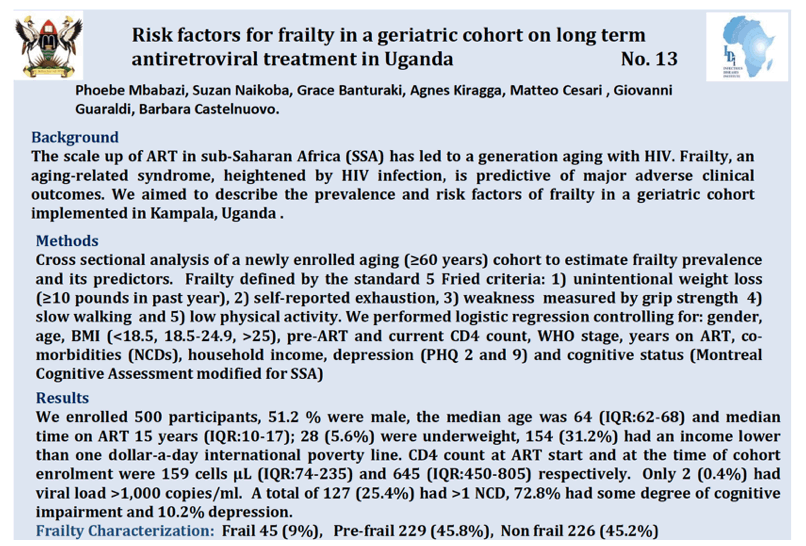 |
 |
 |
| |
50% Frail or Pre-Frail in Uganda: Risk Factors for Frailty in a Geriatric Cohort on Long Term Antiretroviral Treatment in Uganda
|
| |
| |
Aging Workshop Oct 14-15 2022
Reported by Jules Levin

Mbabazi P1, Naikoba S1, Banturaki G1, Kiragga A1, Reid K2, Cesari M3, Siegler E4, Guaraldi G5, Castelnuovo B1
1Infectious Diseases Institute, Kampala, Uganda, 2Havard Medical School, Brigham and Women's Hospital, Boston, USA, 3Universita’ degli Study di Milano, Milan, Italy, 4Weill Cornell Medical College, New York, USA, 5University of Modena e Reggio Emilia, Modena, Italy
Background: Antiretroviral treatment (ART) scale-up has led to a generation aging with HIV in sub-Saharan Africa (SSA). Frailty, an age-related syndrome heightened by HIV infection, is marked by diminished physiologic reserve and vulnerability to stress, and is predictive of adverse clinical outcomes. We determined the prevalence and risk factors of frailty in a geriatric cohort in Kampala, Uganda.
Methods: We determined frailty prevalence and predictors in an aging cohort (≥60 years) enrolled between December 2020 and December 2021. Frailty was defined by criteria proposed by Fried and colleagues: 1)
unintentional weight loss, 2) exhaustion, 3) weakness 4) slow walking, and 5) low physical activity. We performed logistic regression controlling for: gender, age, BMI, pre-ART and current CD4 count, WHO stage, years on ART, co-morbidities (NCDs), household income, depression, and cognitive status.
Results: Of 500 participants, 51.2 % were male, median age was 64 (IQR:62-68) years, and median time on ART was 15 (IQR:10-17) years. Twenty-eight (5.6%) were underweight, and 154 (31.2%) had an income lower than 1 USD/day. CD4 count at the ART start and at the time of enrolment were 159 cells (IQR:74-235) μL and 645 (IQR:450-805) μL, respectively. Two had a viral load >1,000 copies/ml, 151(30.2%) >1 NCD, 72.8% some degree of cognitive impairment, and 10.2%depression.
Forty-five (9%) were frail,
229(45.8%) pre-frail, and 226(45.2%) robust. CD4 count and WHO stage were similar across the three groups.
Men (AOR 0.30, CI: 0.11-0.77, p-value: 0.012), those with normal BMI (AOR 0.06, CI:0.01-0.3, p-value: 0.03), and those overweight (AOR 0.08, CI 0.01-0.48, p-value: 0.005) were less likely to be frail. Participants who were below the poverty line (AOR 2.60, CI: 1.13-6.01, p-value: 0.025), cognitively impaired (AOR 5.70, CI:1.49-21.71, p-value 0.011) and depressed
(AOR 20.68, CI:6.46-66.37 p-value: 0.000) were more likely to be frail.
Conclusion: Despite the exceptional rates of viral suppression and robust CD4 count recovery, more than half of the patients with HIV infection were frail or pre-frail in our cohort, highlighting the clinical relevance of this condition. The assessment of frailty may pave the way for interventions for preventive/multidisciplinary interventions in nutrition, mental health, and lifestyle.


|
| |
|
 |
 |
|
|